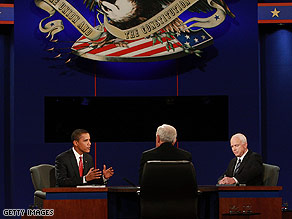 Image via WikipediaHere's something really scary for Halloween. A number of papers are reporting that the Bush administration is trying to put together a mass of deregulation rules before November 11th. The Office of Management and Budget (OMB) has a number of projects under way, and OMB Watch is reporting on them.
Image via WikipediaHere's something really scary for Halloween. A number of papers are reporting that the Bush administration is trying to put together a mass of deregulation rules before November 11th. The Office of Management and Budget (OMB) has a number of projects under way, and OMB Watch is reporting on them.Some may remember that Clinton's administration did the same thing, except in reverse. As the New York Times points out:
Midnight regulations, of course, are nothing new, and the Clinton administration made a name for itself with a raft of last-minute rules of its own. Many were aimed at strengthening environmental regulations and reducing greenhouse emissions.
But in the case of the Bush administration there are as many as 90 new rules under development to unravel environmental protections. Some of the rules are:
- Reduce women's access to federally funded reproductive health services.
- Change the way occupational health agencies calculate estimates for on-the-job risks.
- Allow local law enforcement to engage in domestic spying without good cause
- Erase catch limits on commercial scallop fishing
- Ease rules meant to keep coal slurry waste out of the Appalachian streams
- Allow natural gas pipelines to operate at higher pressures
- Shift passenger security screening responsibilities from commercial airlines to the federal government
- Change the way government agencies comply with the Endangered Species Act. The proposal would allow officials to approve development projects that could impact endangered species without consulting federal wildlife and habitat scientists
- Allow increased emissions from oil refineries, chemical factories and other industrial plants with complex manufacturing operations
- Ease limits on emissions from coal-fired power plants near national parks
- Ease limits on pollution from power plants
The last rule would allow current emissions at a power plant to match the highest levels produced by that plant, overturning a rule that more strictly limits such emission increases. According to the EPA's estimate, it would allow millions of tons of additional carbon dioxide into the atmosphere annually, worsening global warming.
Usually, when these rules take effect they are hard to undo. It requires new regulatory proceedings, including lengthy periods of public comment, drafting and mandated reanalysis. Except in the case of GWB. When he took office in 2001 his chief of staff issued a government-wide memo that blocked the completion or implementation of regulations drafted in the waning days of the Clinton administration that had not yet taken legal effect. That's why this administration is pushing so hard to get the new rules done before mid-November.
Of course, they're also trying to wait until after the elections, since that could hurt any Republicans by association...
![Reblog this post [with Zemanta]](http://img.zemanta.com/reblog_e.png?x-id=061650a2-c0d6-40fc-9a9e-2cc037918b43)



![Reblog this post [with Zemanta]](http://img.zemanta.com/reblog_e.png?x-id=1c083435-bbd5-426e-aa73-de4d31335d71)

![Reblog this post [with Zemanta]](http://img.zemanta.com/reblog_e.png?x-id=ec4abff7-4094-4d26-bf31-7949af3c9375)
![Reblog this post [with Zemanta]](http://img.zemanta.com/reblog_e.png?x-id=46435c4b-648f-4fb6-8a81-278efa175efc)
.JPG)
![Reblog this post [with Zemanta]](http://img.zemanta.com/reblog_e.png?x-id=95337d84-af1a-425c-8f78-e69b52a7fd04)

![Reblog this post [with Zemanta]](http://img.zemanta.com/reblog_e.png?x-id=6f2d82d8-965c-4bf6-9fee-fcf29e064342)
![Reblog this post [with Zemanta]](http://img.zemanta.com/reblog_e.png?x-id=6ce85b95-c1e3-44e6-bc96-d08f6ff6054b)


![Reblog this post [with Zemanta]](http://img.zemanta.com/reblog_e.png?x-id=db48a38d-729e-4338-9f94-91b6a7e9084c)
![Reblog this post [with Zemanta]](http://img.zemanta.com/reblog_e.png?x-id=ee72acf3-0a3a-4939-befb-c5e6e7154848)













![Reblog this post [with Zemanta]](http://img.zemanta.com/reblog_e.png?x-id=b7ce31e2-9aee-4ccc-ae46-e86a8764a50b)

![Reblog this post [with Zemanta]](http://img.zemanta.com/reblog_e.png?x-id=f6d23781-88cb-4812-9746-43787b61c91d)

![Reblog this post [with Zemanta]](http://img.zemanta.com/reblog_e.png?x-id=acd02a7e-fc0a-4c89-b288-dbc1c8f7fe26)

![Reblog this post [with Zemanta]](http://img.zemanta.com/reblog_e.png?x-id=d20d2562-01ae-421f-ac41-86cc39f86d7c)

![Reblog this post [with Zemanta]](http://img.zemanta.com/reblog_e.png?x-id=afe1a0e4-1de1-4c86-a2da-c7879ba52484)


![Reblog this post [with Zemanta]](http://img.zemanta.com/reblog_e.png?x-id=b1e55f27-4ef1-4a15-b74e-357140c5d607)